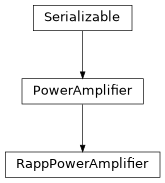Rapp Power Amplifier¶

Model of a power amplifier according to Rapp[1]. Implements a saturation characteristic according to
where \(p_\mathrm{Rapp} \in \lbrace x \in \mathbb{R} | x \geq 1 \rbrace\) denotes the smoothness factor of the saturation curve.
- class RappPowerAmplifier(smoothness_factor=1.0, **kwargs)[source]¶
Bases:
PowerAmplifierModel of a power amplifier according to Rapp’s model.
See Rapp[1] for further details.
- Parameters:
- classmethod Deserialize(process)[source]¶
Deserialize an object’s state.
Objects cannot be deserialized directly, instead a
Factorymust be instructed to carry out the deserialization process.- Parameters:
process (
DeserializationProcess) – The current stage of the deserialization process. This object is generated by theFactoryand provides an interface to deserialization methods supporting multiple backends.- Return type:
- Returns:
The deserialized object.
- model(input_signal)[source]¶
Model signal amplification characteristics.
- Parameters:
input_signal (
ndarray) – Sample vector of the signal feeding into the power amplifier.- Return type:
Returns: Distorted signal after amplification modeling.
- serialize(process)[source]¶
Serialize this object’s state.
Objects cannot be serialized directly, instead a
Factorymust be instructed to carry out the serialization process.- Parameters:
process (
SerializationProcess) – The current stage of the serialization process. This object is generated by theFactoryand provides an interface to serialization methods supporting multiple backends.- Return type:
- property smoothness_factor: float¶
Smoothness factor of the amplification saturation characteristics.
Also referred to as Rapp-factor \(p_\mathrm{Rapp}\).
Returns: Smoothness factor.
- Raises:
ValueError – If smoothness factor is smaller than one.